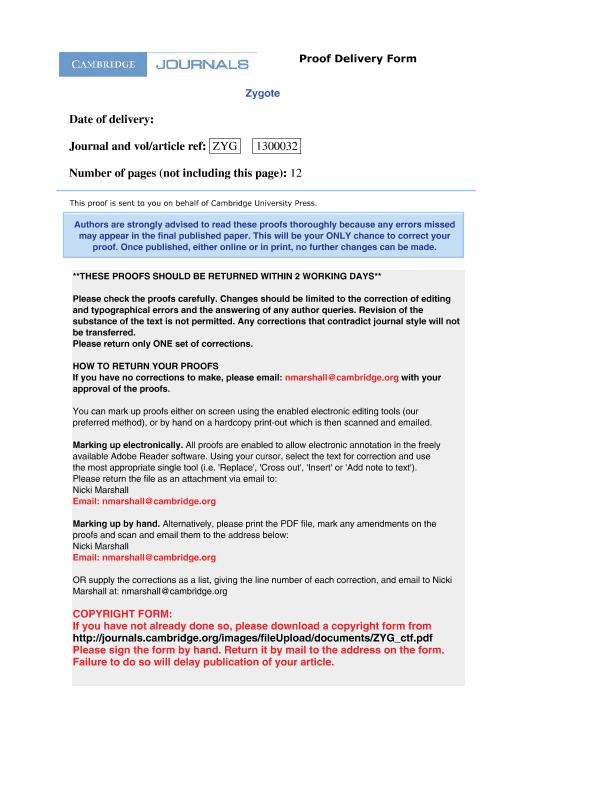Mostrar el registro sencillo del ítem
dc.contributor.author
Serrano, María de Los Angeles

dc.contributor.author
Luque, Melchor Emilio

dc.contributor.author
Sanchez, Sara Serafina del V.

dc.date.available
2017-08-07T20:44:35Z
dc.date.issued
2013-07
dc.identifier.citation
Serrano, María de Los Angeles; Luque, Melchor Emilio; Sanchez, Sara Serafina del V.; Xepac protein and IP3/Ca2+ pathway implication during Xenopus laevis vitellogenesis; Cambridge University Press; Zygote; 23; 1; 7-2013; 99-110
dc.identifier.issn
0967-1994
dc.identifier.uri
http://hdl.handle.net/11336/21989
dc.description.abstract
The objective of this study was to elucidate the signalling pathways initiated by cAMP once inside the Xenopus laevis oocyte, where it triggers and maintains vitellogenin endocytic uptake. Our results showed the presence of Xepac transcripts at all stages of oogenesis and we demonstrated that a cAMP analogue that exclusively activates Xepac, 8-CPT, was able to rescue the endocytic activity in oocytes with uncoupled gap junctions. Inhibition experiments for the IP3/Ca2+ signalling pathway showed either a complete inhibition or a significant reduction of the vitellogenic process. These results were confirmed with the rescue capability of the A-23187 ionophore in those oocyte batches in which the IP3/Ca2+ pathway was inhibited. Taking our findings into account, we propose that the cAMP molecule binds Xepac protein enabling it to activate the IP3/Ca2+ pathway, which is necessary to start and maintain X. laevis vitellogenin uptake.
dc.format
application/pdf
dc.language.iso
eng
dc.publisher
Cambridge University Press

dc.rights
info:eu-repo/semantics/openAccess
dc.rights.uri
https://creativecommons.org/licenses/by-nc-sa/2.5/ar/
dc.subject
Camp
dc.subject
Ip3/Ca2+
dc.subject
Vitellogenesis
dc.subject
Xenopus Laevis
dc.subject.classification
Bioquímica y Biología Molecular

dc.subject.classification
Ciencias Biológicas

dc.subject.classification
CIENCIAS NATURALES Y EXACTAS

dc.title
Xepac protein and IP3/Ca2+ pathway implication during Xenopus laevis vitellogenesis
dc.type
info:eu-repo/semantics/article
dc.type
info:ar-repo/semantics/artículo
dc.type
info:eu-repo/semantics/publishedVersion
dc.date.updated
2017-08-07T17:38:16Z
dc.journal.volume
23
dc.journal.number
1
dc.journal.pagination
99-110
dc.journal.pais
Reino Unido

dc.journal.ciudad
Cambridge
dc.description.fil
Fil: Serrano, María de Los Angeles. Consejo Nacional de Investigaciones Científicas y Técnicas. Centro Científico Tecnológico Conicet - Tucuman. Instituto Superior de Investigaciones Biológicas. Universidad Nacional de Tucuman. Instituto Superior de Investigaciones Biologicas; Argentina
dc.description.fil
Fil: Luque, Melchor Emilio. Consejo Nacional de Investigaciones Científicas y Técnicas. Centro Científico Tecnológico Conicet - Tucuman. Instituto Superior de Investigaciones Biológicas. Universidad Nacional de Tucuman. Instituto Superior de Investigaciones Biologicas; Argentina
dc.description.fil
Fil: Sanchez, Sara Serafina del V.. Consejo Nacional de Investigaciones Científicas y Técnicas. Centro Científico Tecnológico Conicet - Tucuman. Instituto Superior de Investigaciones Biológicas. Universidad Nacional de Tucuman. Instituto Superior de Investigaciones Biologicas; Argentina
dc.journal.title
Zygote

dc.relation.alternativeid
info:eu-repo/semantics/altIdentifier/doi/http://dx.doi.org/10.1017/S0967199413000324
dc.relation.alternativeid
info:eu-repo/semantics/altIdentifier/url/https://www.cambridge.org/core/journals/zygote/article/xepac-protein-and-ip3ca2-pathway-implication-during-xenopus-laevis-vitellogenesis/04B119C289520A30E49BC46E8F534D0E
Archivos asociados
